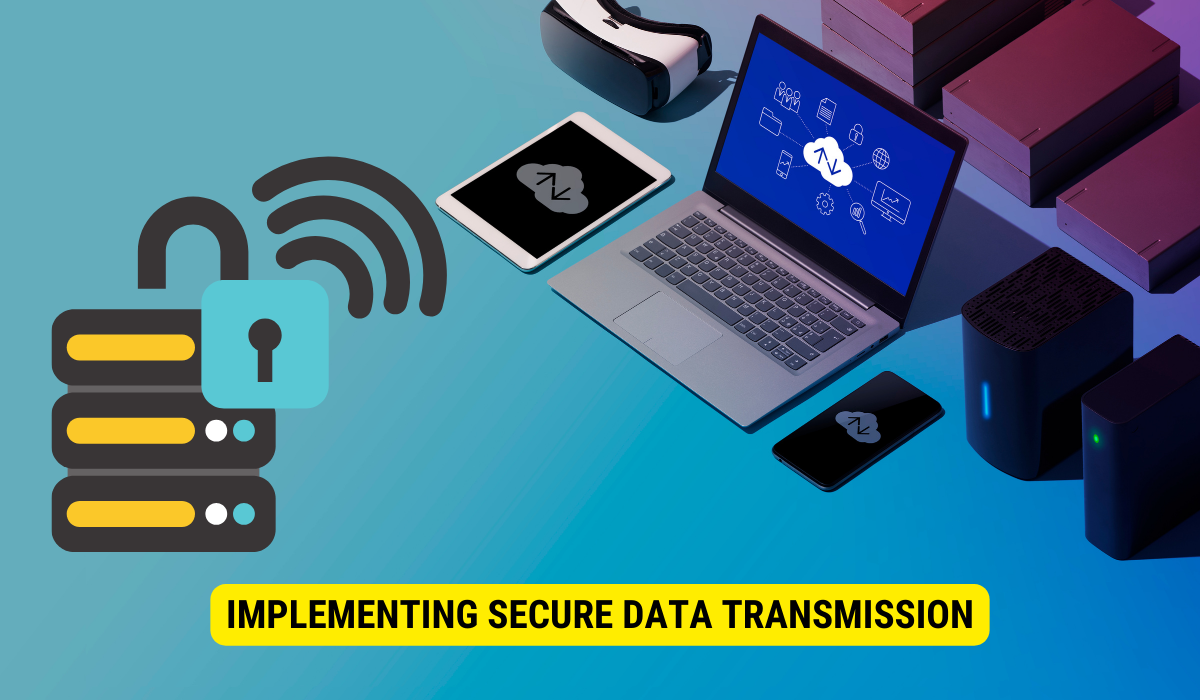To secure client data to a server, businesses should employ a combination of robust measures, including data encryption, secure data transmission protocols like SSL/TLS, server-side security measures such as firewalls and intrusion detection systems, and sound data storage practices that encompass regular backups and strong access controls.
In today’s digital age, the security of client data is of utmost importance. Businesses hold valuable data that must be protected against potential threats and breaches. Companies can safeguard sensitive information from unauthorized access by executing robust security measures, such as data encryption, secure data transmission, server security measures, and secure data storage practices. I will delve into the several aspects of securing client data to the server. Let’s explore the importance of data security and the measures one can take to ensure its safety.
Understanding the Importance of Data Security
Data serves as the backbone of any modern business. It fuels decision-making processes, enables efficient operations, and enables companies to gain a competitive edge. However, the value of data also makes it an attractive target for cybercriminals. A successful data breach could lead to severe consequences, with financial losses, damage to reputation, and legal implications.
The Role of Data in Business
Data plays a vital role in various business aspects. It drives customer insights, enables personalized marketing strategies, and facilitates targeted advertising campaigns. Additionally, data is instrumental in enhancing operational efficiency, optimizing supply chains, and streamlining business processes. With data being a crucial asset, protecting it from potential risks is imperative.
Let’s delve deeper into the importance of data in business. Customer insights derived from data analysis provide valuable information about consumer behavior, preferences, and trends. This knowledge permits businesses to tailor their products and services to meet their target audience’s specific needs and desires. By understanding customer preferences, businesses can create personalized marketing strategies that resonate with their customers more deeply.
Moreover, data plays a significant role in facilitating targeted advertising campaigns. Businesses can recognize the most relevant audience segments for their products or services by examining customer data. This allows them to create highly targeted and effective advertising campaigns, resulting in advanced conversion rates and increased return on investment.
On the operational side, data is crucial for optimizing supply chains and streamlining business processes. By analyzing data related to inventory levels, production rates, and customer demand, businesses can make informed decisions to ensure efficient operations. This results in reduced expenses, increased efficiency, and heightened client contentment.
Potential Risks of Data Breaches
Before diving into security measures, it is important to understand the potential risks related with data breaches. Such breaches can occur due to various factors, including external cyberattacks, internal threats, system vulnerabilities, and human error. Losing control over sensitive data can result in financial loss, damage to brand reputation, customer attrition, and non-compliance with data protection regulations.
External cyberattacks pose a significant threat to data security. Hackers and cybercriminals constantly evolve their techniques to exploit vulnerabilities in systems and networks. They employ sophisticated techniques like phishing, malware infiltration, and ransomware assaults are employed to illicitly acquire entry to confidential information. The outcomes of a triumphant cyber assault can be profoundly destructive with financial losses running into millions of dollars and irreparable damage to a company’s reputation.
Internal threats are another major concern when it comes to data security. Employees with malicious intent or those unaware of proper security protocols can inadvertently compromise sensitive data. This can happen through unauthorized data access, sharing sensitive information with unauthorized individuals, or falling victim to social engineering tactics.
System vulnerabilities also pose a significant risk to data security. Cybercriminals can exploit software and hardware vulnerabilities to gain unauthorized entree to systems and steal sensitive data. It is vital for businesses to regularly update and patch their systems to mitigate these vulnerabilities and stay one step forward of potential attackers.
Lastly, human error can also lead to data breaches. Mistakes such as misconfigurations, accidental data exposure, or inappropriate handling of sensitive information can result in data breaches. Businesses need to educate their employees about data security best practices and deliver regular training to minimize the risk of human error.
As businesses continue to rely deeply on data, the importance of data security cannot be overstated. Implementing robust security measures, staying updated with the latest security technologies, and fostering a culture of data security within the organization are crucial steps in safeguarding sensitive data from potential risks.
Basics of Data Encryption
Data encryption is a fundamental method for protecting sensitive information from unauthorized access. It involves encoding data using an algorithm, making it unreadable to anyone without the decoding key. By leveraging data encryption techniques, businesses can ensure that even if data falls into the wrong hands, it remains incomprehensible.
Data encryption plays a crucial role in safeguarding sensitive data in various industries. For example, in the healthcare sector, patient records containing personal information such as medical history, diagnoses, and treatments are encrypted to prevent unauthorized individuals from accessing and misusing this sensitive data. Similarly, financial institutions employ data encryption to protect customer information, including bank account details and credit card numbers, from potential hackers and identity thieves.
What is Data Encryption?
Data encryption converts plain, readable data into a coded format known as ciphertext. Encryption algorithms use complex mathematical formulas and keys to transform data in a way that can only be deciphered by authorized parties possessing the corresponding decryption key.
When data is encrypted, it undergoes a series of transformations that render it incomprehensible to anyone without the decryption key. This ensures that even if an unauthorized person gains access to the encrypted data, they cannot understand its contents or extract any valuable information from it.
Different Types of Data Encryption
Various data encryption algorithms exist, each offering unique strengths and weaknesses. Some common encryption methods include symmetric encryption, asymmetric encryption, and hashing.
Symmetric encryption, also referred to as secret key encryption, customs a single shared key for encryption and decryption. This means the same key is used to scramble and unscramble the data. Symmetric encryption is fast and efficient, making it suitable for encrypting large amounts of data. However, the challenge lies in securely sharing the key between the sender and the recipient, as any compromise would render the encryption useless.
Asymmetric encryption, also recognized as public key encryption, employs a pair of keys: public and private keys. The public key is used for encoding, while the private key is used for decryption. This method delivers a higher level of security as the private key remains secret and is never shared. Asymmetric encryption is commonly used in secure communication protocols such as SSL/TLS, which confirms preserving the confidentiality and ensuring the integrity of data sent via the Internet is of paramount importance.
Hashing, however, creates a fixed-length string of characters based on the original data. Unlike encryption, hashing is a one-way process, meaning the original data cannot be derived from the hash value. Hash functions commonly verify data integrity by comparing the computed and original hash values. This ensures the data has not been tampered with or modified during transmission or storage.
Understanding the different types of data encryption allows organizations to choose the most suitable method based on their specific security requirements. By implementing robust encryption techniques, businesses can protect their sensitive data from unauthorized access, ensuring the privacy and confidentiality of their information.
Implementing Secure Data Transmission
Data transmission refers to sending data from one location to another. As data travels across networks, it is susceptible to interception by malicious actors. To mitigate this risk, secure data transmission protocols must be implemented.
Secure Sockets Layer (SSL) and Transport Layer Security (TLS)
SSL and TLS are cryptographic protocols that deliver secure message over the Internet. These protocols use encryption algorithms to ensure the confidentiality and integrity of data during transmission. SSL and TLS are widely used in online transactions, email communication, and secure browsing.
Virtual Private Networks (VPNs)

A Virtual Private Network enables secure remote access to corporate networks over the Internet. VPNs protect data from unauthorized access and eavesdropping by establishing an encrypted connection between the user’s device and the company’s network. VPNs are particularly useful when employees need to access sensitive data while working remotely.
Server Security Measures
Securing the server that stores client data is critical for preventing unauthorized access and minimizing potential vulnerabilities.
Firewalls and Intrusion Detection Systems
Firewalls are a barrier between a secured internal and external network, filtering incoming and outgoing traffic based on predefined security rules. Intrusion Detection Systems (IDS) monitor network activity and identify potential threats, providing early warnings of unauthorized access attempts or suspicious behavior.
Regular Software Updates and Patches
Software updates and patches often include security fixes that address known vulnerabilities. Keeping the server’s software updated with the latest patches is crucial for minimizing security risks. Regular updates close any potential doors that hackers may exploit.
Secure Data Storage Practices
Implementing secure data storage practices ensures the protection and integrity of client data, even when it is at rest.
Data Backup and Recovery
Data backup and recovery strategies are essential for maintaining data availability and mitigating the impact of potential data loss. Regular backups, off-site storage, and redundant systems contribute to data resilience and ensure business continuity.
Access Controls and Authentication
Access controls and authentication mechanisms are crucial for restricting unauthorized access to sensitive data. Strong password policies, multi-factor authentication, and role-based entree control (RBAC) enable companies to grant appropriate access rights based on individual needs and responsibilities.
FAQs
What is the role of data encryption in securing client data?
Data encryption transforms readable data into a coded format, making it unreadable to anyone without the decryption key, thus ensuring data remains secure even if accessed by unauthorized individuals.
How does Secure Sockets Layer (SSL) enhance data security during transmission?
SSL is a cryptographic protocol that encrypts data during transmission, ensuring its confidentiality and integrity over the Internet.
Why are regular software updates and patches crucial for server security?
Software updates and patches often address known vulnerabilities, protecting the server against potential security threats.
What is the significance of data backup and recovery in data security?
Data backup and recovery ensure data availability, safeguarding against potential data loss and enabling business continuity in case of unexpected events.
How do access controls contribute to secure data storage?
Access controls restrict unauthorized access to sensitive data by granting access rights based on individual roles and responsibilities, ensuring only authorized personnel can access the data.
Key Takeaways
- Data security is pivotal in today’s business landscape due to the critical role of data in decision-making and the potential risks associated with data breaches.
- Data encryption, which includes symmetric and asymmetric encryption, is fundamental for safeguarding sensitive information in storage and transit.
- Secure data transmission protocols like SSL/TLS provide a safe conduit for data over the Internet, shielding it from interception and tampering.
- Server security is enhanced with tools like firewalls, intrusion detection systems, and regular software updates to mitigate known vulnerabilities.
- Employing secure data storage practices, which include regular backups, access controls, and authentication mechanisms, ensures the protection of client data at all times.
Conclusion
Protecting client data should be a top priority for every business. By understanding the importance of data security and implementing robust measures such as data encryption, secure data transmission, server security measures, and secure data storage practices, companies can safeguard sensitive information and gain the trust of their clients. Stay vigilant, stay secure!
